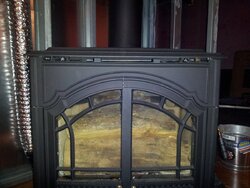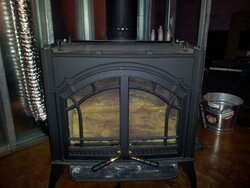I find myself lurking on hearth.com more and more each week, looking for answers for the hundreds of questions that pop into my head. I've reached the point where I'm just going to start asking the experts, all of you...
I've read a TON of posts on burn times on this forum. My wife and I work full time with 4 small children (5 years, 4 years, 2 years and 7 months) so I'm trying to get the best burn time out of my Cumberland Gap. I know the manufacturer overstates the burn times (I think 15 hours is grossly overstated in this case) but I am only semi-satisfied with with ~7 hours of burn time I'm getting. I'd like to stretch it to about 8-10 with more coals at the end...more coals at 8 hours would make me plenty happy. I installed a flue thermometer this year and it has helped serve as a good guide. I'd like to add a stove-top thermometer, but there is a 1/2-inch gap between the firebox top and the cast-iron top on my stove. With my IR gun, the cast iron top definitely seems to take longer to heat up. In fact, I think I may have overfired a bit last year waiting for it to get to 450-500 and quite frankly still wasn't getting good burn times, probably because of too much combustion initially. So, here are my questions (at least on this topic)
1) Should I remove the cast iron top and just place a thermometer directly on the steel firebox top? Would this be a more accurate measure? I looked at pics of the Isle Royale (since it's in the same Quad family and it's a popular stove on this forum) but it doesn't seem to have the same spacing. This gap is definitely vented, probably intentionally for some reason?
2) I'm wondering if maybe I am getting too much outgassing once the fire gets going, which may be why my times are not as long as I would like. I tried the "cigar burn" method that I read in other posts. It seems to work sometimes, but those flames go where they want and sometimes start catching all of it.
3) I don't think it's the problem, but it could be a slight problem with strong draft. I have 23 ft of class A chimney pipe, with 2 offsets/returns. I think all 30-degrees. The stove pipe also has 2-45's. Once I get it good and hot and nice secondaries, I can close it all the way down and usually still get decent flames from the bottom of the firebox. Not sure if this should be happening, or only getting the "dancing flames" at the top.
4) At what flue temp should I start shutting down the primary? It's my first year with the stove pipe thermometer (Condar) so I'm still experimenting with what works best. What flue temps should I expect for cruising?
5) Am I expecting too much from a 2.4 cu. ft. firebox? Are my expectations unrealistic? I'm not expecting to get the advertised 15 hour burn times, just hoping to make it manageable enough that after I get home from work (let's say 8-10 hours, minimum) I still have decent enough coals that I can easily reload and not have to overly-combust the new wood and lose a bunch of "mass" to get stove up to temp.
I've read a TON of posts on burn times on this forum. My wife and I work full time with 4 small children (5 years, 4 years, 2 years and 7 months) so I'm trying to get the best burn time out of my Cumberland Gap. I know the manufacturer overstates the burn times (I think 15 hours is grossly overstated in this case) but I am only semi-satisfied with with ~7 hours of burn time I'm getting. I'd like to stretch it to about 8-10 with more coals at the end...more coals at 8 hours would make me plenty happy. I installed a flue thermometer this year and it has helped serve as a good guide. I'd like to add a stove-top thermometer, but there is a 1/2-inch gap between the firebox top and the cast-iron top on my stove. With my IR gun, the cast iron top definitely seems to take longer to heat up. In fact, I think I may have overfired a bit last year waiting for it to get to 450-500 and quite frankly still wasn't getting good burn times, probably because of too much combustion initially. So, here are my questions (at least on this topic)
1) Should I remove the cast iron top and just place a thermometer directly on the steel firebox top? Would this be a more accurate measure? I looked at pics of the Isle Royale (since it's in the same Quad family and it's a popular stove on this forum) but it doesn't seem to have the same spacing. This gap is definitely vented, probably intentionally for some reason?
2) I'm wondering if maybe I am getting too much outgassing once the fire gets going, which may be why my times are not as long as I would like. I tried the "cigar burn" method that I read in other posts. It seems to work sometimes, but those flames go where they want and sometimes start catching all of it.
3) I don't think it's the problem, but it could be a slight problem with strong draft. I have 23 ft of class A chimney pipe, with 2 offsets/returns. I think all 30-degrees. The stove pipe also has 2-45's. Once I get it good and hot and nice secondaries, I can close it all the way down and usually still get decent flames from the bottom of the firebox. Not sure if this should be happening, or only getting the "dancing flames" at the top.
4) At what flue temp should I start shutting down the primary? It's my first year with the stove pipe thermometer (Condar) so I'm still experimenting with what works best. What flue temps should I expect for cruising?
5) Am I expecting too much from a 2.4 cu. ft. firebox? Are my expectations unrealistic? I'm not expecting to get the advertised 15 hour burn times, just hoping to make it manageable enough that after I get home from work (let's say 8-10 hours, minimum) I still have decent enough coals that I can easily reload and not have to overly-combust the new wood and lose a bunch of "mass" to get stove up to temp.





